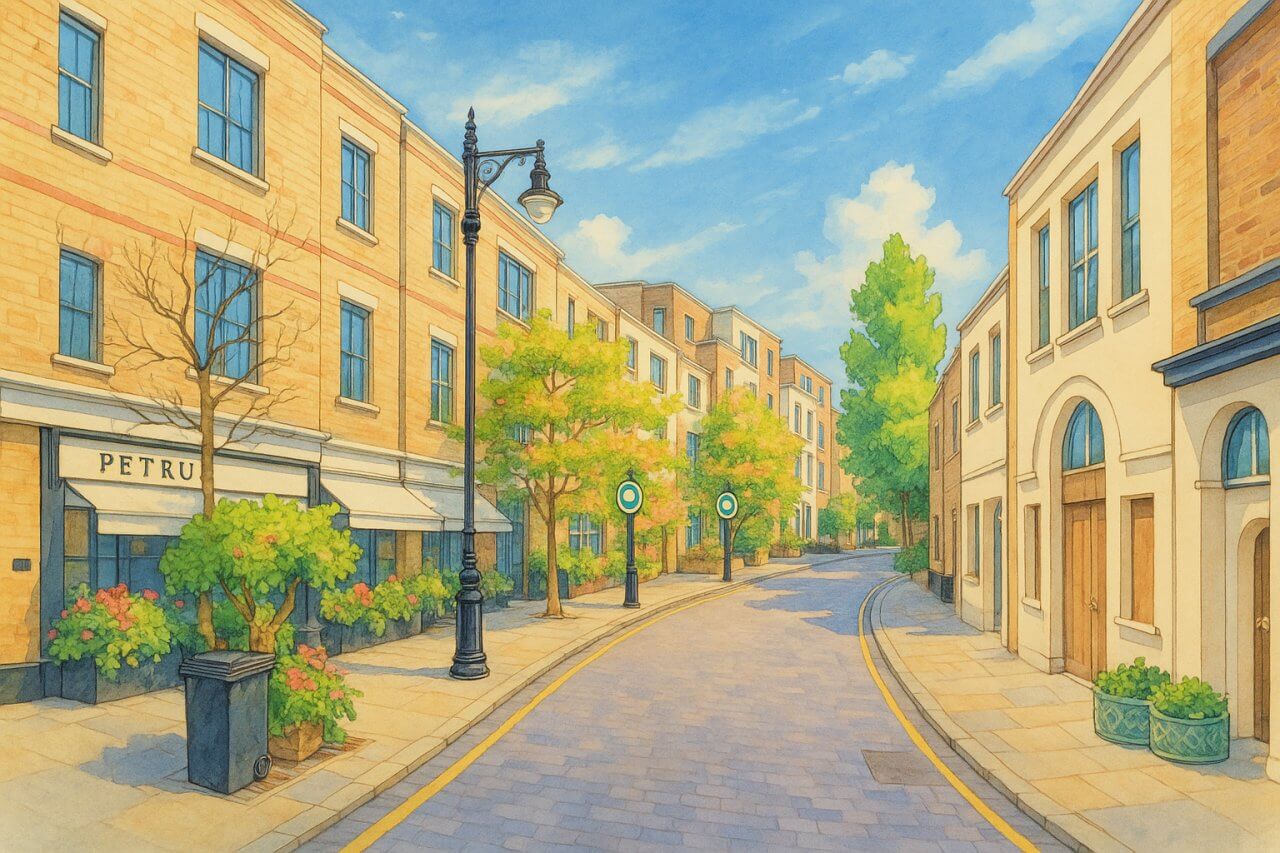
Kinnerton Street, London
Pronounced “KIN-ər-tən” (/ˈkɪnərtən/  ), Kinnerton Street is a picturesque, narrow road tucked into the heart of Belgravia, City of Westminster. Divided into two distinct segments that meet at a T-junction, this understated street retains the air of a secret passageway hidden in one of London's most prestigious neighbourhoods.
), Kinnerton Street is a picturesque, narrow road tucked into the heart of Belgravia, City of Westminster. Divided into two distinct segments that meet at a T-junction, this understated street retains the air of a secret passageway hidden in one of London's most prestigious neighbourhoods.
Layout and Traffic Flow
Kinnerton Street consists of a main segment that runs from Motcomb Street and a shorter, secondary segment that connects to Wilton Place. The two sections converge at a T-junction about halfway along. The section linked to Wilton Place is a one-way street heading west, while the longer segment from Motcomb Street accommodates two-way traffic, despite its narrow, mews-like proportions that more closely resemble an alley than a standard London street.
Measured from end to end, Kinnerton Street spans approximately 270 metres (886 feet), making it a relatively short, intimate road. The combination of narrow width and low traffic contributes to its quiet, residential character, even though it lies close to busy Knightsbridge.
Historical Background
Kinnerton Street traces its origins to the early 19th century, when it was first laid out as a service street at the rear of the grand mansions lining Wilton Crescent and Belgrave Square. It was historically associated with stables, servants’ quarters, and tradespeople, reflecting the hierarchical urban planning of the Georgian and early Victorian periods.
The name Kinnerton is believed to be derived from a village in Flintshire, Wales, possibly chosen to reflect aristocratic ties or estate ownership. The pronunciation—“KIN-ər-tən”—is consistent with other anglicised Welsh place names. The street likely received its official name during the early 1800s, concurrent with the wider development of the Belgravia estate by the Grosvenor family.
Character and Atmosphere
Today, Kinnerton Street blends its historic, utilitarian roots with an unmistakably upscale charm. The buildings are mostly former mews houses, once used for horses and carriages, now converted into elegant residences. The architecture reflects a combination of Georgian and early Victorian styles, with modest frontages, pastel facades, and arched doorways. Despite its relatively humble origins, Kinnerton Street has become one of the most desirable mews-style roads in Belgravia.
The atmosphere is calm and neighbourly. Flower boxes, iron railings, and the absence of chain stores reinforce the feeling of a tucked-away village. There is also a strong sense of privacy—this is not a street that casual pedestrians often stumble upon, making it a peaceful retreat amid central London’s bustle.
Nearby Attractions and Points of Interest
- Motcomb Street – At the eastern end of Kinnerton Street, this stylish lane offers boutique shopping, upscale cafes, and fine dining.
- Hyde Park – A short walk to the north leads to one of London’s grandest open spaces.
- Belgrave Square – Just a block south, this leafy garden square is lined with embassies and historic townhouses.
- Lowndes Square – Another elegant residential square nearby.
- The Grenadier Pub – Located on nearby Wilton Row, this historic and reputedly haunted pub is a local favourite.
Property and Real Estate
As of early 2025, residential property prices on Kinnerton Street remain at a premium, consistent with its Belgravia location. Mews homes on the street often range from 1,200 to 1,800 square feet (111 to 167 sq metres). Prices start around £2.5 million and can reach over £5 million depending on size, refurbishment, and exact location along the street1.
This places Kinnerton Street above average for London, but below the astronomical prices of the grand terraces nearby in Eaton Square or Belgrave Square. It is particularly attractive to buyers seeking a more intimate, village-like setting with prime central access.
Transport Connections
Nearest London Underground Stations
- Knightsbridge Station (Piccadilly line) – approx. 5 minutes’ walk. Direct access to the West End, Heathrow Airport, and King’s Cross.
- Hyde Park Corner Station (Piccadilly line) – approx. 7 minutes’ walk.
- Sloane Square Station (District and Circle lines) – approx. 15 minutes’ walk.
Nearby Bus Routes
The nearest bus stops are located along Wilton Place and Knightsbridge, offering routes such as:
- Bus 9 – Hammersmith to Aldwych
- Bus 14 – Putney to Russell Square
- Bus 19 – Battersea Bridge to Finsbury Park
- Bus 22 – Putney to Oxford Circus
Fun Fact
In the early 20th century, Kinnerton Street had a rather different reputation—it was known for being a “back door” street, once lined with small workshops, coach houses, and even a few illicit drinking dens. Its dramatic transformation into a tranquil residential haven is a quintessential example of London’s evolving urban landscape.
Quick Facts
- Location: Belgravia, City of Westminster, London
- Length: Approx. 270 metres (886 feet)
- Traffic: One-way on Wilton Place segment; two-way on main section
- Pronunciation: “KIN-ər-tən” (/ˈkɪnərtən/)
- Historic Origin: Early 19th century mews street
- Character: Quiet, residential, narrow, and elegant
- Nearest Tube Stations: Knightsbridge, Hyde Park Corner, Sloane Square
- Nearby Bus Routes: 9, 14, 19, 22 (via Knightsbridge and Wilton Place)
- Average Home Size: 1,200–1,800 sq ft (111–167 sq m)
- Property Prices (2025): £2.5m to £5m
- Nearby Attractions: Motcomb Street, Hyde Park, Belgrave Square, The Grenadier Pub
References
Map of Kinnerton Street, London

Painting of Kinnerton Street, London (View image in full size)